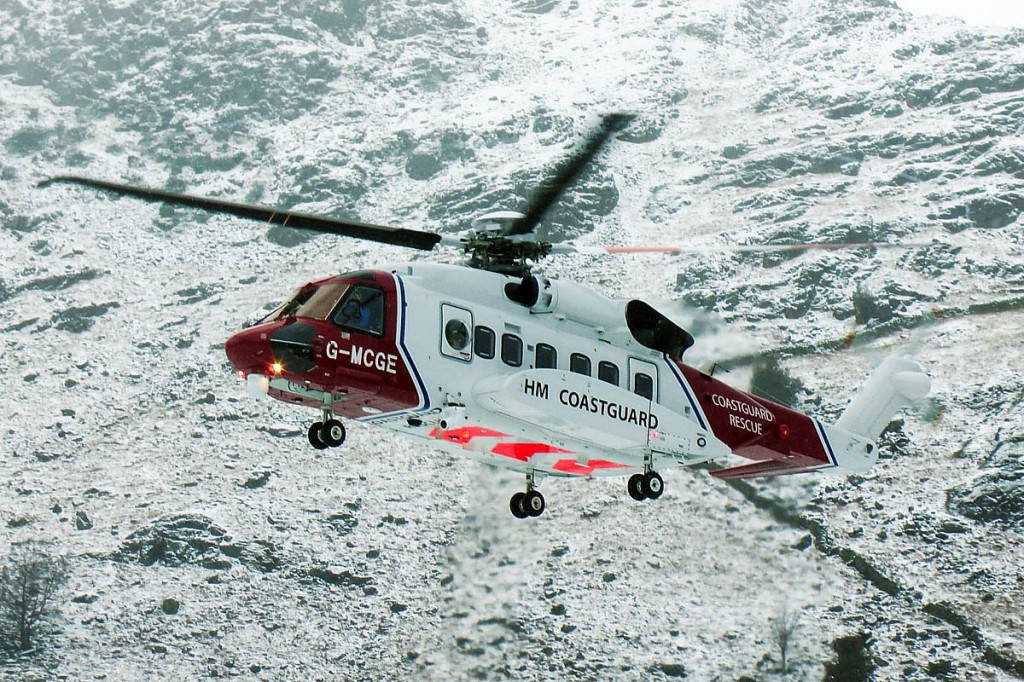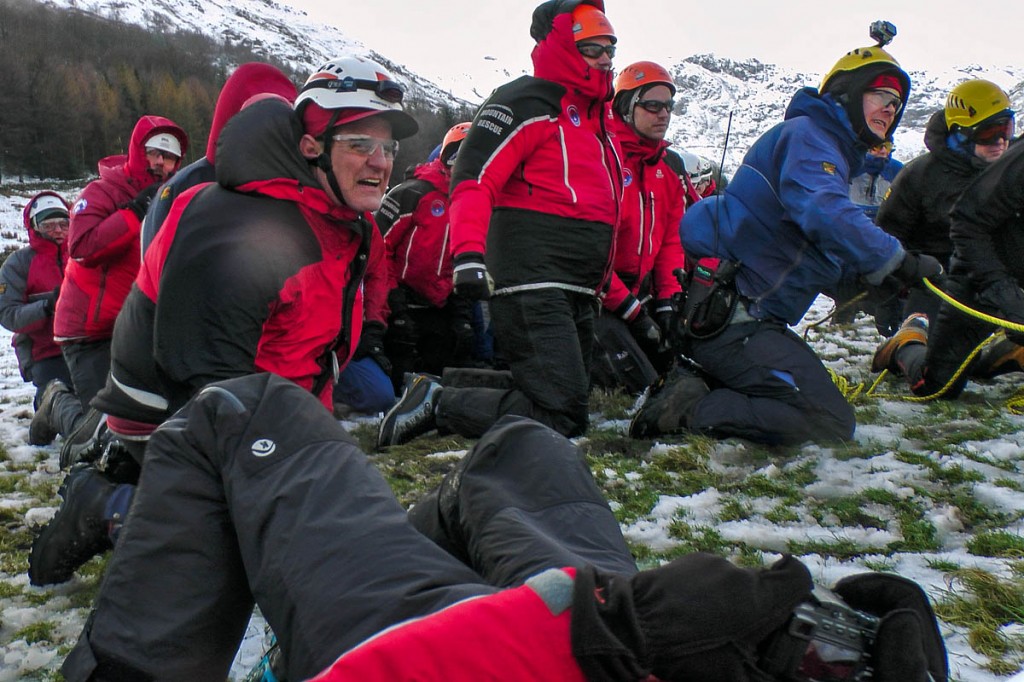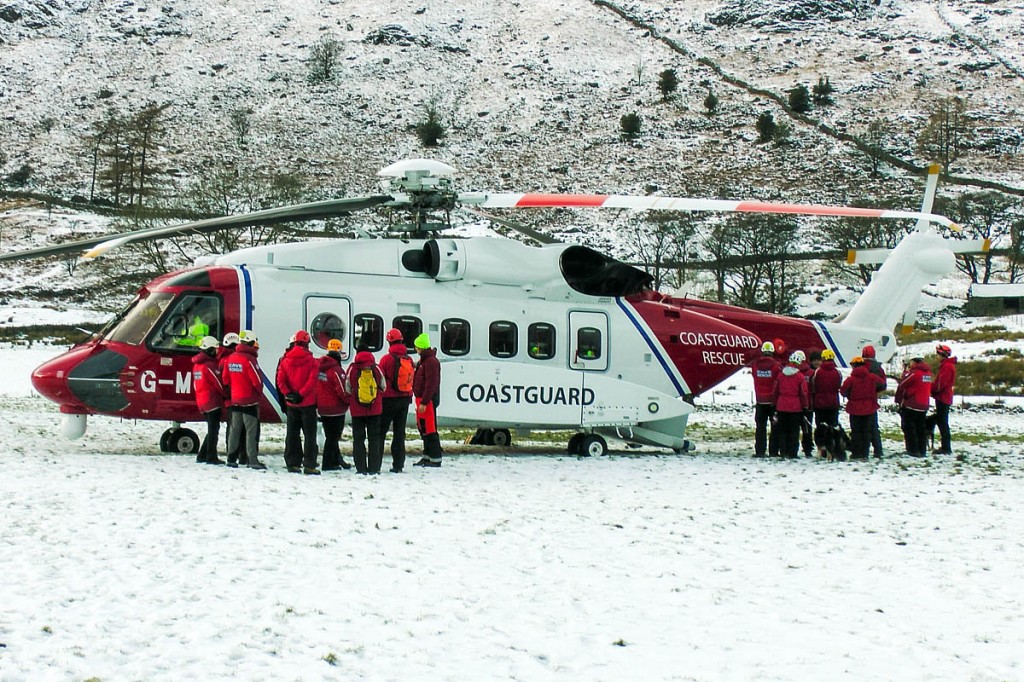Volunteer mountain rescuers from the Lake District had their first look at the new privatised search and rescue helicopters that will support them from spring.
The Bristow-owned aircraft will replace RAF and Royal Navy Sea Kings in mountain rescue operations across the UK.
The £1.6bn contract was awarded to the Texas-based company almost two years ago and will run for 13 years. The new helicopters, in Coastguard livery, will be operated under the responsibility of the Department for Transport, through the Maritime and Coastguard Agency.
The service will use Sikorsky S-92 and Agusta Westland AW189 helicopters in place of the ageing Sea Kings that have been the mainstay of search and rescue operations in the UK for decades.
Sixty rescuers from 10 different teams took part in the training exercise on Saturday to familiarise themselves with one of the new aircraft.
Richard Warren of the Lake District Search and Mountain Rescue Association said: “The unmistakable thunder of this maritime coastguard helicopter was heard across Cumbria prior to it touching down at the south end of Thirlmere reservoir on Saturday morning to work through a programme of training with the Lake District teams.
“This was the first outing for the brand new helicopter at the start of an intensive training process aimed at getting over 1,000 volunteer mountain rescue team members from across the North of England through the essential safety training before the new SAR service becomes fully operational on 1 April.
“The two-hour training sessions included familiarisation of the helicopter externals, capabilities and limitations followed by detailed safety briefings from inside the comfort of the cabin which seats up to 11 rescuers along with two casualty stretchers.
“This training is extremely important as a prerequisite to flying, so that when a rescue team needs to bring in a helicopter in the middle the night in foul weather conditions, team members know exactly what needs to be done in the cabin area, where to sit and can safely access and egress the aircraft either by the entrance doors or being winched in and out.
“Particular attention is paid to the safety briefing and how to crash out through the windows. Understandably, all team members were fully attentive during this and all other parts of the training.
“The final experience for team members was hands on practice of the high-line. The high- line is a rope that is fed out by two team members and tightly held by the winchman as he is winched up with the stretcher to prevent him spinning under the fierce downwash from the rotors.
“Team members huddled directly beneath the helicopter hovering above at a height of about 30m were subjected to a battering as the freezing air, forced down by the massive rotor blades, attempted to rip away anything that was not securely tied including the eye protection which is extremely important.”
The privatised service will use 22 helicopters, operating from 10 Coastguard bases around the UK.
The service will begin progressively from 1 April at a number of stations including Humberside and Caernarfon in North Wales and will gradually replace the ageing military Sea Kings that have been in service for the past decades.
The scrambling of all rescue aircraft will continue to be from the Aeronautical Rescue Coordination Centre at Kinloss, in Moray for the time being. The ARCC is currently manned by existing RAF military personnel but over the next 12 to 18 months the role will go to the MCA’s national maritime coordination centre in Fareham, Hampshire.
The helicopter involved in Saturday’s training was the Sikorsky S-92 based at Humberside, which is due to ‘go-live’ on 1 April.
But Mr Warren said he helicopter most likely to be used for most incidents in the Lake District will be the smaller Agusta Westland AW189 based at Prestwick in Ayrshire. The base at Prestwick will operate from 1January 2016. During the transition period, the Lake District teams will continue to be served by RAF Boulmer in Northumberland and HMS Gannet at a separate site at Prestwick.
The new aircraft will have icing protection systems, a medical suite and latest management systems including high-definition forward-looking infra-red; automated search and target acquisition’ radar and GPS.
The helicopters will be used for search and rescue over both land and sea. The police are responsible for land operations while the MCA are in charge of coordination of rescues over the sea and coast, and four of the major waters in the Lake District, Windermere, Coniston Water, Ullswater and Derwent Water.
Mr Warren expressed his thanks to the farmer and residents of West Head Farm who allowed the teams to use the location for training.



Richard Warren
19 January 2015Just a slight but important correction to the above, it is not a privatisation of search and rescue, it is a contracted service to the MCA who will retain responsibility for search and rescue. The Coastguard have operated a contracted helicopter service at Manston Airfield since 1971. The 22 helicopters are owned by the MCA and operated by Bristow on their behalf. The coordination of SAR helicopters will remain a state activity (through the ARCC)
Richard Warren
Chairman LDSAMRA
Ellie
20 January 2015Can we have some advice please on how to summon MR? Do you use echo112? What happens in the UK when someone uses that? Exactly what information should we have ready? Thanks
Hoping of course that we can manage most situations ourselves but you never know what you are going to encounter.
Bob
20 January 2015Hi Ellie
grough ran a story a little while ago: http://www.grough.co.uk/magazine/2014/11/26/when-things-go-wrong-how-to-call-out-mountain-rescue on how to go about calling MR.
In the UK, mountain rescue volunteers are mobilised by the police via either the 999 or 112 number.
Ambulances only deal with, essentially, roadside on street medical emergencies.
Bob, editor
Hiding in the hills
20 January 2015Good luck with that then. Those Sikorskys are a nightmare. Almost impossible to do winch work underneath when they are hovering because of the incredible downdraught from the huge rotors. In the Coastguard ones, the seating is mounted over the emergency hatches and has to be removed for access, they are very cramped inside and the ground clearance for the NightSun and the camera pod is less than 3", so they can't land on soft ground.
Other than that, congratulations to the decision makers and planners.
Here's a thought... one of the principal uses for helicopters all over the world is search and rescue. Why is there not one single manufacturer of helicopters out there making an aircraft to replace the Sea King with that specific purpose in mind?